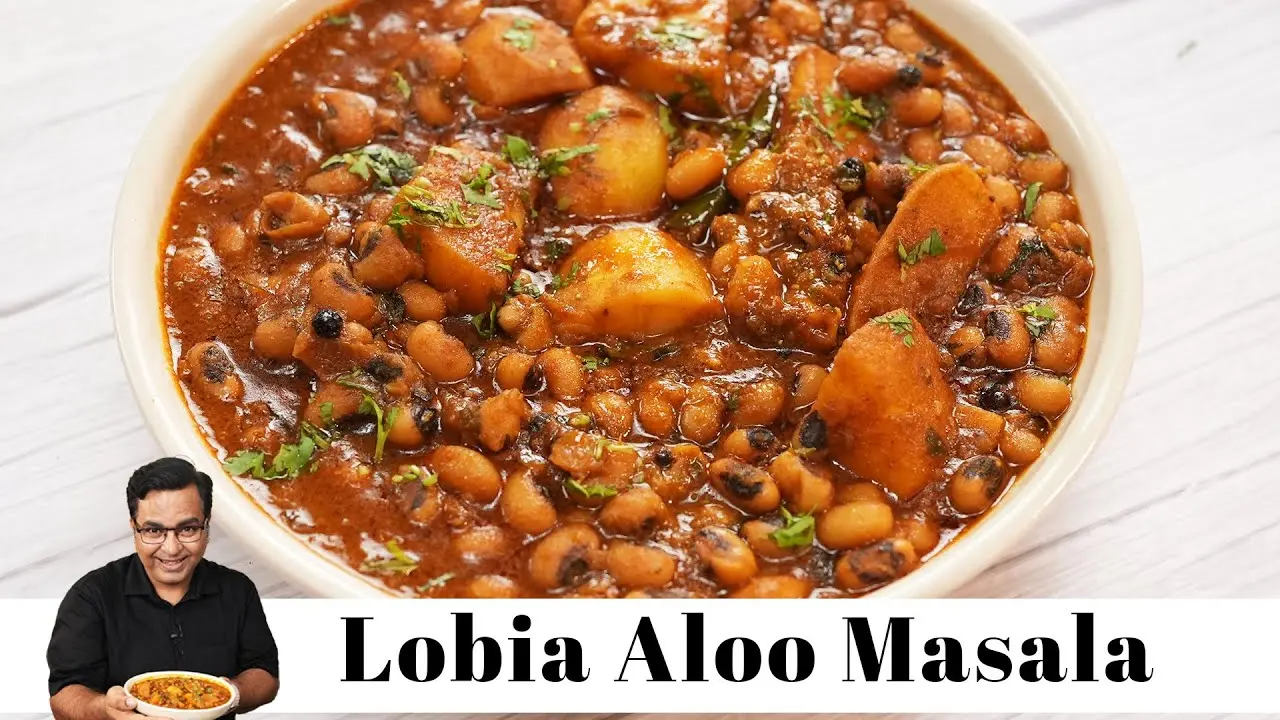
Lobia Aloo Masala Recipe

50 Mins

6-7 People

2 Hours
Introduction
Lobia Aloo Masala has always been a heartwarming dish for me, reminiscent of family gatherings and homely comfort. I remember the first time I tasted this delectable recipe during a festive celebration at my grandmother's house. The aroma of mustard oil and spices wafting through the air and the sight of golden-brown potatoes and tender lobia made me fall in love with this dish instantly.
One interesting fact about Lobia Aloo Masala is its versatility. Known by various names like black-eyed peas or white rajma, lobia can be prepared in countless ways across India. This particular recipe, enriched with spices and a tangy touch of yogurt, brings out the robust flavors of North Indian cuisine. Now, let me share this delightful recipe that has become a staple in my kitchen and is sure to become a favorite in yours too.
Recipe of Lobia Aloo Masala
Portion: Serves 6-7
Preparation Time: 2 hours
Cooking Time: 50 minutes
Ingredients
For Pressure Cooking Lobia:
- 200 gms Lobia (black-eyed peas), soaked
- 1 tbsp Mustard oil
- 1 Onion, half sliced
- 1 pc Black cardamom
- 2 pcs Cloves
- 1 pc Bayleaf
- 1 tsp Salt
For Frying Potatoes:
- 2 tbsp Mustard oil
- 2 pcs Potatoes, diced
For Masala:
- 2 pcs Bayleaf
- 5-8 pcs Black peppercorns
- 1 pc Black cardamom
- 2-3 pcs Green cardamom
- 4-5 pcs Cloves
- 2 Onions, chopped
- 2 Green chilies, chopped
- 1 ½ tbsp Ginger & garlic paste
- 1 tsp Saunf powder (fennel seed powder)
- 1 tsp Sabji masala (vegetable masala)
- 1 tsp Salt
- 1 tsp Coriander powder
- 1 tsp Red chili powder
- ½ tsp Jeera powder (cumin powder)
- ½ tsp Turmeric powder
- ½ tsp Garam masala
- ½ cup Curd (yogurt)
- 1 tbsp Kasoori methi (dried fenugreek leaves)
- 1 tbsp Fresh coriander, chopped
For Combining:
- Diced cooked potatoes (from frying)
- Boiled lobia (from pressure cooking)
- Water as required
- 1 tbsp Fresh coriander, chopped (for garnish)
Instructions
Step 1: Pressure Cook the Lobia
-
Prepare Ingredients:
- Take the soaked lobia and drain the water.
-
Add to Cooker:
- Place the lobia in a pressure cooker along with sliced onion, black cardamom, cloves, and bay leaf.
- Add 1 tbsp of mustard oil and 1 tsp of salt for flavor.
-
Pressure Cook:
- Add enough water to cover the lobia, and close the pressure cooker.
- Cook on medium heat for 4-5 whistles until the lobia is soft and cooked through.
- Once done, release the pressure and set the lobia aside.
Step 2: Fry the Potatoes
-
Heat Oil:
- In a large pan, heat 2 tbsp of mustard oil over medium heat.
-
Fry Potatoes:
- Add the diced potatoes and fry until they are golden brown and crispy.
- Remove the potatoes from the pan and set them aside on a plate.
Step 3: Prepare the Masala
-
Heat Oil:
- In the same pan, add more mustard oil if needed and heat over medium flame.
-
Add Whole Spices:
- Add bay leaves, black cardamom, black peppercorns, green cardamom, and cloves.
- Sauté the spices until they release a fragrant aroma.
-
Add Onions and Chilies:
- Add chopped onions and green chilies to the pan.
- Cook until the onions turn golden brown and caramelized.
-
Add Ginger-Garlic Paste:
- Stir in the ginger-garlic paste and cook until the raw smell disappears.
-
Add Spices:
- Add saunf powder, sabji masala, salt, coriander powder, red chili powder, turmeric powder, and cumin powder.
- Cook the spices on low heat, stirring constantly to avoid burning.
Step 4: Incorporate Curd and Herbs
-
Turn Off Heat:
- Turn off the heat to prevent curd from curdling.
-
Add Curd:
- Stir in the curd slowly, mixing continuously to combine with the masala.
-
Add Kasoori Methi and Coriander:
- Add kasoori methi and freshly chopped coriander leaves. Mix well to incorporate the flavors.
Step 5: Combine Ingredients
-
Add Lobia:
- Add the cooked lobia to the pan along with some of the cooking liquid.
-
Add Potatoes:
- Gently stir in the fried potatoes, ensuring they are well coated with the masala.
-
Simmer:
- Simmer the mixture on low heat, allowing the flavors to meld. Add water as needed to adjust the consistency.
Step 6: Serve
-
Garnish:
- Garnish with freshly chopped coriander.
-
Serve:
- Serve the Lobia Aloo Masala hot with steamed rice or soft parathas. Enjoy the rich, aromatic flavors of this hearty dish.
About the Recipe
Lobia Aloo Masala is a classic North Indian dish that combines the earthy flavors of black-eyed peas (lobia) with the crispiness of fried potatoes, all simmered in a tangy yogurt-based gravy. This dish is perfect for those who crave a hearty and wholesome meal, packed with protein and spices. The use of mustard oil adds a distinct, pungent flavor that complements the aromatic spices like cloves, cinnamon, and bay leaves.
The recipe is straightforward yet rich in taste, making it a fantastic choice for family dinners or special occasions. Whether you serve it with rice, jeera pulao, or hot parathas, Lobia Aloo Masala promises a delightful culinary experience that brings the essence of traditional Indian cooking to your table.
Cooking Tips
- Soaking Lobia: Always soak lobia overnight or for at least 6-8 hours. This helps in reducing the cooking time and makes the beans tender.
- Mustard Oil: Using mustard oil is crucial for an authentic flavor. Heat the oil until it smokes lightly to remove its raw smell.
- Yogurt Consistency: Ensure the yogurt is at room temperature and whisk it well before adding to avoid curdling.
- Frying Potatoes: Fry the potatoes until they are golden brown to add a nice texture and prevent them from becoming mushy in the gravy.
- Balancing Spices: Adjust the amount of red chili powder and green chilies based on your spice tolerance. You can also add a pinch of sugar to balance the tanginess of the yogurt.
Pairing Guide
- Rice: Lobia Aloo Masala pairs wonderfully with steamed rice or jeera rice. The rice helps absorb the rich flavors of the gravy.
- Parathas: Serve it with hot parathas or chapatis for a satisfying and hearty meal.
- Pickles: A side of tangy Indian pickle complements the flavors and adds an extra zing.
- Salad: A simple cucumber and onion salad with a dash of lemon juice can add a refreshing crunch to your meal.
- Raita: A bowl of plain yogurt or cucumber raita helps balance the spices and enhances the overall dining experience.
Frequently Asked Questions about Lobia Aloo Masala Recipe
-
What is Lobia Aloo Masala?
- Lobia Aloo Masala is a North Indian dish made with black-eyed peas (lobia) and potatoes (aloo) cooked in a spiced yogurt-based gravy.
-
Can I use canned lobia for this recipe?
- Yes, you can use canned lobia to save time. Just make sure to rinse them well to remove any excess salt.
-
Is there a substitute for mustard oil?
- If you don’t have mustard oil, you can use vegetable oil or ghee, but mustard oil is recommended for its unique flavor.
-
Can I make this recipe without yogurt?
- Yes, you can substitute yogurt with tomato puree for a tangier flavor or use coconut milk for a creamy variation.
-
How do I store leftovers?
- Store leftovers in an airtight container in the refrigerator for up to 3 days. Reheat in a pan over low heat, adding a splash of water if needed.
-
Can I make Lobia Aloo Masala in a slow cooker?
- Yes, you can prepare it in a slow cooker. Sauté the spices and onions first, then transfer to the slow cooker along with the other ingredients and cook on low for 6-8 hours.
-
Is Lobia Aloo Masala gluten-free?
- Yes, this recipe is naturally gluten-free, as it doesn't require any gluten-containing ingredients.
-
Can I add other vegetables to this dish?
- Absolutely! You can add vegetables like carrots, peas, or bell peppers to make it more nutritious and colorful.
-
How can I make this recipe less spicy?
- To reduce the spice level, cut down on the green chilies and red chili powder. You can also add more yogurt or a dash of cream to mellow the flavors.
-
What other dishes can I serve with Lobia Aloo Masala?
- Lobia Aloo Masala goes well with Indian breads like naan or roti, and you can also serve it with a side of dal or a light vegetable curry for a complete meal.
I hope you enjoy making and savoring Lobia Aloo Masala as much as I do. This dish is not only a treat for your taste buds but also a comforting reminder of home-cooked goodness. Happy cooking!
